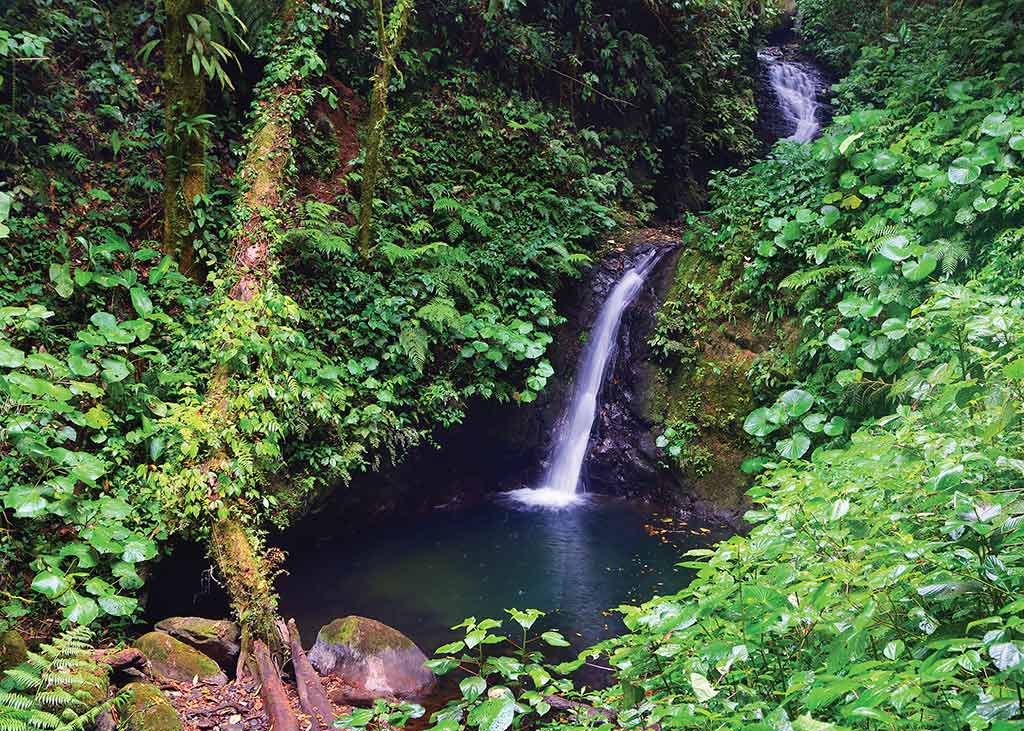Monteverde, 35 kilometers (22 miles) north from the Pan-American Highway, means “Green Mountain,” an appropriate name for one of the most idyllic pastoral settings in Costa Rica. Cows munch contentedly, and horse-drawn wagons loaded with milk cans still make the rounds in this world-famous community atop a secluded 1,400-meter-high (4,600-foot-high) plateau in the Cordillera de Tilarán. Monteverde is actually a sprawling agricultural community; the Reserva Biológica Bosque Nuboso Monteverde (Monteverde Cloud Forest Biological Reserve), which is what most visitors come to see, is a few kilometers southeast and higher up. A growing number of attractions are found north of Santa Elena, the main village, which has its own cloud-forest reserve. The two reserves are at different elevations and have different fauna and flora.

Waterfall in Monteverde Cloud Forest Reserve. Photo © Christopher P. Baker.
February through May, quetzals are in the cloud forest. Later, they migrate downhill, where they can be seen around the hotels of Monteverde.The reserves are within the Zona Protectora Arenal-Monteverde (Arenal-Monteverde Protected Zone). Created in 1991, it encompasses more than 30,000 hectares (74,000 acres) extending down both the Caribbean and Pacific slopes of the Cordillera de Tilarán, passing through eight distinct ecological zones, most notably cloud forest at higher elevations. Wind-battered elfin woods on exposed ridges are spectacularly dwarfed, whereas more protected areas have majestically tall trees festooned with orchids, bromeliads, ferns, and vines. Clouds sift through the forest primeval. February through May, quetzals are in the cloud forest. Later, they migrate downhill, where they can be seen around the hotels of Monteverde. Just after dawn is a good time to spot quetzals, which are particularly active in the early morning, especially in April and May.The fame of the preserve has spawned an ever-increasing influx of tourists and a blossoming of attractions—the area is in danger of becoming overdeveloped and overpriced. The government’s announcement, in 2013, that it would finally pave the road up to Monteverde will probably speed up the process.
The village of Santa Elena is the service center, with banks, stores, and bars. Populated by Tico families, Santa Elena is commonly considered to be Monteverde, although Monteverde proper is strung out along the road that leads up to the Reserva Biológica Bosque Nuboso Monteverde and is predominantly populated by the descendants of North American Quakers. Separating the two communities is the region of Cerro Plano.
The 14,200-hectare (35,090-acre) Reserva Biológica Bosque Nuboso Monteverde (Monteverde Cloud Forest Biological Reserve, tel. 506/2645-5122, 7am-4pm daily, adults $18, children and students $9), six kilometers (4 miles) east of Santa Elena, is owned and administered by the Tropical Science Center of Costa Rica.
The reserve protects more than 100 species of mammals, more than 400 species of birds, and more than 1,200 species of amphibians and reptiles. It is one of the few remaining habitats of all six indigenous species of the cat family: jaguar (on the lower slopes), ocelot, puma, margay, oncilla, and jaguarundi. Bird species include black guan, emerald toucanet, the critically endangered three-wattled bellbird, whose metallic “bonk!” call carries for almost three kilometers (2 miles), and 30 local hummingbird species. Hundreds of visitors arrive in hopes of seeing a resplendent quetzal; approximately 200 pairs nest in the reserve. Cognoscenti know that ironically, the parking lot is perhaps the best place to see quetzals; in March 2014 it’s where I saw a quetzal, perched like a museum piece, almost within reach. Go early in the morning.

A hanging bridge in the Monteverde Cloud Forest. Photo © Focus on Nature Photography.
The reserve has 13 kilometers (8 miles) of trails for day visitors concentrated in an area called The Triangle. Parts ooze with mud; other sections have been covered with raised wooden walkways. A maximum of 180 people are allowed on the trails at any one time. Access is first come, first served, except for those already booked on guided tours.
Longer trails requiring an overnight stay lead down the Pacific slopes. Sendero Valle leads to La Cascada, a triple waterfall, and continues via the valley of the Río Peñas Blancas to Pocosol, about 20 kilometers (12 miles) south of La Fortuna. These are for experienced Indiana Jones-type hikers only (the three basic backpacking shelters are closed until further notice). Reservations are essential, and a guide is obligatory for these longer trails.
If you want to hike alone, buy your ticket the day before and set out before the crowds. You increase your chances of seeing wildlife if you hike with a guide; reservations are advisable (book online at www.reservamonteverde.com, from $18). Three-hour guided tours (caminatas) are offered at 7:30am, noon, and 1:30pm daily (minimum 3 people, maximum 9 people, adults $32, students $18, including admission); hourly tours are planned. A five-hour bird-watching tour ($64 pp, including admission) is offered at 6am daily. A two-hour night hike ($17, with hotel transfers $22) is offered at 6:15pm daily.
Bring warm clothing and rain gear. You can rent rubber boots in many hotels. The visitors center rents binoculars ($10 per day, plus deposit) and sells a self-guided pamphlet, a trail map, and wildlife guides.
A café at the visitors center serves omelets ($1.75), burgers, sandwiches, mochas ($1), and other fare. A bus (tel. 506/2645-6296) departs Santa Elena for the reserve ($1 each way) at 6:15am, 7:20am, 9:20am, 1:20pm, and 3pm daily, returning at 6:45am, 7:45am, 11:30am, 2pm, and 4pm daily. Most hotels can arrange transportation. A taxi from Santa Elena should cost about $10 one-way, but there are reports of gouging. Parking is available.
Excerpted from the Tenth Edition of Moon Costa Rica.